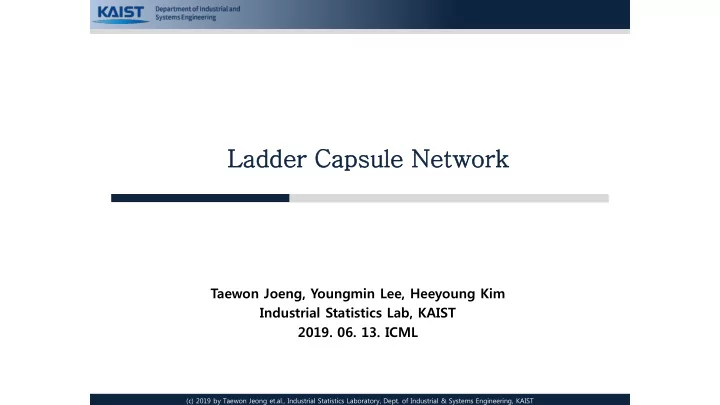

Ladder Capsule Network Taewon Joeng, Youngmin Lee, Heeyoung Kim Industrial Statistics Lab, KAIST 2019. 06. 13. ICML (c) 2019 by Taewon Jeong et.al., Industrial Statistics Laboratory, Dept. of Industrial & Systems Engineering, KAIST
Capsule Network Components of Capsule Network (CapsNet) • Basically, the architecture of CapsNet is similar to other feed-forward networks, but uses capsules instead of neurons. • The output of capsule represents 2 properties of an entity: (1) pose (2) probability of existence (activation), which have the forms of a vector and a logistic unit, respectively. Capsules make it possible to learn an equivariant representation. • Capsules in higher-level and lower-level layers stand for a whole (e.g. human face) and parts (e.g. left and right eyes, mouth), respectively. To capture the “part - whole” relationship, CapsNet uses the dynamic routing algorithm as an “agreement rule”. 2 (c) 2019 by Taewon Jeong et.al, Industrial Statistics Laboratory, Dept. of Industrial & Systems Engineering, KAIST
Capsule Network Dynamic Routing Algorithm Left eye Predictions 𝑣 𝑘|𝑗 = 𝑋 𝑗𝑘 𝑣 𝑗 (prediction matrix 𝑋 𝑗𝑘 ) Right eye Agreement: update Mouth coupling coefficients 𝑑 𝑗𝑘 … and higher-level capsule 𝑤 𝑘 iteratively Other capsules Irrelevant to human face 3 (c) 2019 by Taewon Jeong et.al, Industrial Statistics Laboratory, Dept. of Industrial & Systems Engineering, KAIST
Ladder Capsule Network New Ideas … Other capsules • Dynamic routing algorithm Irrelevant to Left eye Right eye Mouth human face computes the prediction of higher-level capsule from all of lower level capsules, even though some of them are irrelevant. • Direction of agreement rule: Instead of the agreement of prediction from lower level to higher level, regression from higher level to lower level could be used for agreement rule. From higher to lower level From lower to higher level(DR) 4 (c) 2019 by Taewon Jeong et.al, Industrial Statistics Laboratory, Dept. of Industrial & Systems Engineering, KAIST
Ladder Capsule Network Pruning & Ladder Layers • Pruning layer: selects the K relevant capsules among all lower-level capsules, and propagates them to the layer above. Code vector, which is 0-1 encoded to indicate which capsules are selected, is also propagated to the layer above. • Ladder layer: constructs higher-level capsule, and regresses the K selected lower level capsules from higher-level capsule. 5 (c) 2019 by Taewon Jeong et.al, Industrial Statistics Laboratory, Dept. of Industrial & Systems Engineering, KAIST
Ladder Capsule Network Pruning Layer • Given a pre-fixed number K, choose the K most active capsules among all lower level capsules (i.e. pruning the capsules based on the activation) Code vector, which contains the information about which capsules are selected. 6 (c) 2019 by Taewon Jeong et.al, Industrial Statistics Laboratory, Dept. of Industrial & Systems Engineering, KAIST
Ladder Capsule Network Ladder Layer K-selected capsules from pruning layer Regression of K Construct higher selected capsules level capsule Left eye Right eye Regression matrix Transformation matrix : NN of code vector : NN of code vector Mouth • Unlike the dynamic routing algorithm, the ladder layer does not require several iterations to compute the agreement, thus reduces the computing cost. 7 (c) 2019 by Taewon Jeong et.al, Industrial Statistics Laboratory, Dept. of Industrial & Systems Engineering, KAIST
Ladder Capsule Network Experiments 8 (c) 2019 by Taewon Jeong et.al, Industrial Statistics Laboratory, Dept. of Industrial & Systems Engineering, KAIST
Recommend
More recommend